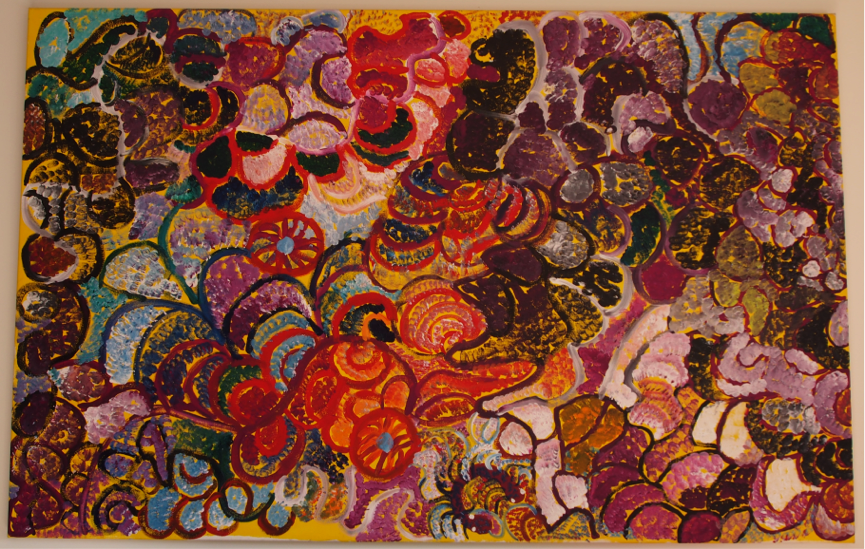Kalita Kalita is the visual story of the rock hole where bats live. The bats hang from the roof of the cave. The daily coming in and going out of the colony of bats inspired this early work of Alkawari Dawson a senior law woman of the Irrunytju community. Born in 1930 near Warburton Alkawari lived and worked for most of her life in Irrunytju, a community of Pitjantjatjara and Ngaanyatjarra peoples in the tri state boarder region of Western Australia. At the time of Irrunytju Artists was still an official Aboriginal-owned art centre. After she commenced painting in 2000 and until her death in 2010 Alkawari painted the stories of her dreaming and the country she loved.
Kalita Kalita spokes to me from the moment I saw the image as a photograph online. The colour and vibrancy of the work compelled me to visit the gallery where the painting was on display, and I have loved the painting ever since. Kalita Kalita is a commanding piece that invites me to sit and meditate on its colour, image and compilation of shapes. Never before had I seen something so beautiful with a power to captivate me, draw me in and compel me to sit and explore each nook and cranny of what is an enormous canvas.
Using a sunflower yellow as the base Dawson builds colour or more accurately weaves colour into the canvas. What appears to be the central part of the piece, an almost perfect circle in reds and orange with a sky blue centre, is on closer analysis only one of many focal points that could be the central or core element of the work.
The painting is a meditation in colour as it invites understanding and recognition of the power colour can create. If given the time the work draws the viewer into various moods of colour that seem to deepen to exactly the right hue before they explode into quite a different tone that, although a jolt, appears absolutely perfect on closer reflection.
The fluidness of Dawson’s brush strokes is innately feminine and their certainty suggests the powerful purpose of women. As the curvaceous shapes build from the bottom to the top of the canvas in a steady flow they suddenly shift or change direction. With this change in direction emerges new colour, new life and a new pathway.
In 2006 Kalita Kalita was one of six works by Alkawari Dawson in an exhibition called County in Mind: Five contemporary Aboriginal artists at the Ian Potter Museum of Art in Melbourne, Australia. Director of The Ian Potter Museum of Art Dr Chris McAuliffe stated in the exhibition catalogue that the five artists featured were chosen because they “declared an engagement with community and place, but they also demonstrated an ongoing reflection on materials, process, scale, meaning and self-expression”. (1)
It is this reflection on meaning and self-expression in Kalita Kalita that spoke to me. Its massive proportions, 130cm x 200cm, dominate any space large enough to hold it and the vibrant colour palette speaks loudly to anyone who has the courage to interpret its visual message.
As I study, absorb and learn from the ebb and flow of this amazing painting it appears as a visual metaphor for the joy, colour and the change that is possible in life. In Kalita Kalita a change in direction brings change in colour and form. With variations in the natural light the work also changes its mood. The coral greens take on a light blue tone as the sun heightens the intensity of light in the room. When the light fades the vibrant purples take on a more sombre tone. When I purchased the piece nine years ago it spoke to me of beauty and courageous ideas. It represented a joyous self-expression that I was compelled to share.
As the central piece in my indigenous collection Alkawari Dawson’s Kalita Kalita continues to reward my intuitive first response. Its colour joy and undefinable air of excitement rewards me daily if I take the time to sit with it and myself.
Alkawari Dawson’s paintings are held in the collections of The National Gallery of Victoria, The Art Gallery of Western Australia and numerous private collectors.
Linette Etheredge
Reference:
1) DR. MCAULIFFE, Chris. “Foreword catalogue 2006”, Country in Mind: Five contemporary Aboriginal artists. The Ian Potter Museum of Art.
About the Author:
Linette Etheredge is an art collector, documentary filmmaker and teacher from Melbourne Australia.
Artwork © The Artist – Photo Courtesy Linette Etheredge
